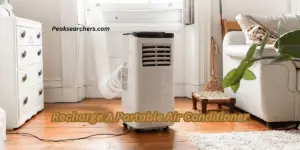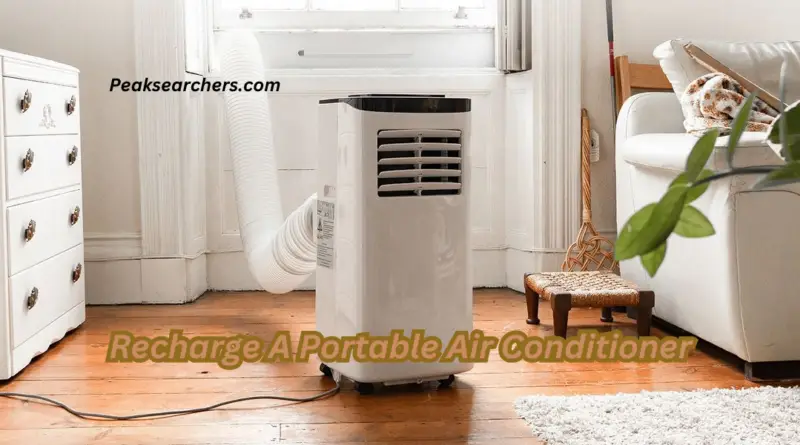Can You Recharge A Portable Air Conditioner? A Comprehensive Guide
Welcome to our comprehensive guide on how to recharge a portable air conditioner. If you’re facing issues with the cooling performance of your portable air conditioner, recharging it can be a cost-effective solution. In this article, we will provide you with step-by-step instructions to help you recharge your portable air conditioner and restore its optimal cooling capabilities.

Understanding the Recharging Process
Before we delve into the recharging process, it’s important to note that not all portable air conditioners are designed to be recharged. Some models are meant to be used until they lose their cooling capacity and then replaced. However, if your portable air conditioner is rechargeable, you can follow the steps outlined below.
Why Recharge a Portable Air Conditioner?
Over time, the refrigerant in a portable air conditioner may deplete due to normal usage or small leaks. This can result in a decrease in cooling performance and overall efficiency. Recharging the unit with the appropriate refrigerant can help restore its cooling capabilities and ensure optimal operation.
Determining Recharge Needs
If you’re uncertain whether your portable air conditioner needs to be recharged, there are a few signs to look out for:
- Insufficient cooling: If you’ve noticed a significant decrease in the cooling capacity of your air conditioner, even when set to the lowest temperature, it may be an indication that a recharge is necessary.
- Longer cooling cycles: If the air conditioner runs for extended periods without achieving the desired temperature, it could be a sign that the refrigerant levels are low.
- Ice buildup: Excessive ice formation on the evaporator coils or other components of the unit may suggest a refrigerant issue.
Step 1: Gather the Necessary Tools and Materials
To recharge your portable air conditioner, you’ll need the following tools and materials:
- Refrigerant: Check your portable air conditioner’s user manual to determine the specific type of refrigerant required. It’s crucial to use the correct refrigerant to ensure optimal performance and avoid damage to the unit.
- Screwdriver: Depending on your air conditioner model, you may need a screwdriver to access the refrigerant ports.
- Safety goggles and gloves: It’s essential to protect yourself during the recharging process. Safety goggles and gloves will prevent any accidental contact with the refrigerant.
Step 2: Preparation and Safety Measures
Before proceeding with the recharging process, it’s important to take the necessary safety precautions:
- Turn off and unplug the portable air conditioner: Ensure that the unit is completely disconnected from any power source before starting the recharging process. This will prevent any electrical accidents or damage to the unit.
- Find a well-ventilated area: Recharging a portable air conditioner involves handling refrigerant, which can be potentially harmful if inhaled. Choose a well-ventilated area, preferably outdoors, to ensure proper air circulation.
- Wear safety goggles and gloves: Put on your safety goggles and gloves to protect your eyes and skin from any potential contact with the refrigerant.
Step 3: Locating the Refrigerant Ports
To recharge your portable air conditioner, you’ll need to locate the refrigerant ports. These ports are typically found on the back or side of the unit. Use the screwdriver, if required, to remove any screws or panels obstructing access to the ports.
Step 4: Recharging the Portable Air Conditioner
Now that you’ve prepared the necessary tools and taken safety precautions, it’s time to recharge your portable air conditioner. Follow these steps carefully:
- Attach the refrigerant canister: Attach the refrigerant canister to the charging hose according to the manufacturer’s instructions. Ensure a secure connection to prevent any leaks.
- Connect the charging hose to the refrigerant port: Insert the charging hose into the refrigerant port of the portable air conditioner. Make sure it fits tightly to avoid any refrigerant leakage.
- Begin the recharging process: Open the valve on the refrigerant canister to start the recharging process. Monitor the pressure gauge on the canister and follow the manufacturer’s instructions to determine the appropriate amount of refrigerant to recharge.
- Close the refrigerant port: Once the desired amount of refrigerant has been recharged, close the refrigerant port securely.
Step 5: Testing and Finishing Up
After recharging your portable air conditioner, it’s essential to test its performance to ensure it’s functioning optimally:
- Plug in the unit: Plug the portable air conditioner back into the power source.
- Turn on the air conditioner: Set the desired temperature and turn on the portable air conditioner. Allow it to run for a while and observe the cooling performance.
- Check for any leaks: Inspect the refrigerant ports and connections for any signs of leakage. If you notice any leaks, tighten the connections or seek professional assistance.
Seeking Professional Assistance
While recharging a portable air conditioner can be done as a DIY task, it’s important to recognize your limitations. If you’re uncomfortable or unsure about the process, it’s advisable to seek professional assistance. HVAC technicians have the expertise and equipment to safely recharge your unit and address any underlying issues.
Regular Maintenance for Optimal Performance
To maintain the efficiency and longevity of your portable air conditioner, regular maintenance is essential. In addition to recharging, consider the following maintenance practices:
- Clean the air filters: Dirty or clogged filters can hinder airflow and reduce cooling performance. Clean or replace the filters regularly to ensure proper air circulation.
- Clear obstructions: Keep the area around the unit clear of any obstructions that could restrict airflows, such as furniture, curtains, or other objects.
- Routine inspections: Periodically check for any leaks, loose connections, or signs of damage. Promptly address any issues to prevent further problems.
By incorporating these maintenance practices, you can maximize the efficiency and lifespan of your portable air conditioner.
Remember, if you’re unsure about any aspect of recharging or maintaining your portable air conditioner, it’s always best to consult the manufacturer’s guidelines or seek professional assistance.
Also Read: Do Portable Air Conditioners Use A Lot Of Electricity? A DIY Guide
FAQ’s
Do portable air conditioners have refrigerant?
Yes, portable air conditioners have refrigerant. It is a key component that helps in the cooling process by absorbing heat from the indoor air and releasing it outside.
The type and amount of refrigerant used can vary, so it’s important to follow the manufacturer’s guidelines for recharging or handling the refrigerant.
If you suspect low levels or a leak, consult the user manual or a professional technician for assistance. Proper handling of refrigerant is crucial for optimal cooling and safety.
Portable air conditioner recharge kit?
Yes, recharge kits are available for portable air conditioners. These kits include the necessary components, such as refrigerant and a charging hose, to recharge the unit.
It’s important to choose a kit that is compatible with your specific air conditioner model. However, for more complex issues, it’s recommended to consult a professional technician. Safety precautions should be followed when using a recharge kit.
Which AC recharge kit do I need?
To determine the AC recharge kit you need for your specific air conditioner, it is crucial to refer to the manufacturer’s guidelines or user manual. Different air conditioner models may require different types of refrigerant and have specific requirements for the recharge process.
The manufacturer’s guidelines will provide information on the compatible refrigerant type, the recommended quantity, and any specific instructions for using a recharge kit. Following these guidelines will ensure that you select the appropriate recharge kit for your air conditioner and avoid any potential damage or safety issues.
If you’re uncertain about which recharge kit to use or have any questions regarding the process, it is advisable to contact the manufacturer or consult a professional technician who can provide accurate guidance based on your air conditioner’s specifications.
Also Read: Do Portable Air Conditioners Need To Be Drained? A Comprehensive Guide
Conclusion
Recharging a portable air conditioner can be a practical solution to restore its cooling capabilities. By following the step-by-step instructions provided in this guide, you can safely and effectively recharge your portable air conditioner. Remember to always consult the user manual specific to your unit and prioritize safety throughout the process. Enjoy the cool comfort provided by your recharged portable air conditioner!


